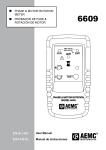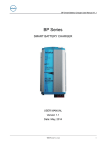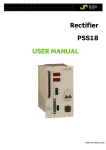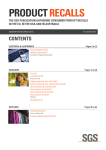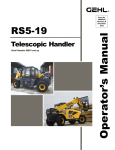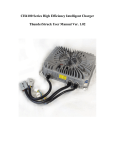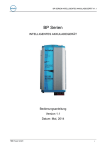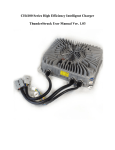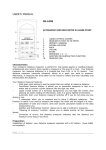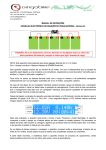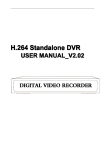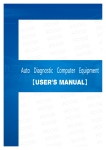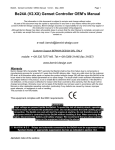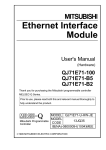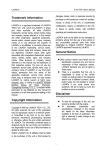Download About TBB Disclaimer Date and Revision Contact Information
Transcript
About TBB TBB Power Co.,Ltd is a professional advanced power electronics manufacturer for marine, recycle energy applications, products of which includes battery charger, pure sine wave inverter etc. With belief of “pursuit of perfection”, we will keep supplying high quality products with innovations. Disclaimer Unless specially agreed in writing, TBB Power Co.,Ltd a> Take no warranty as to the accuracy, sufficiency of suitability of any technical or other information provided in this manual or other documentation b> Assumes no responsibility or liability for loss or damage, whether direct, indirect, consequential or incidental, which might arise out of the use of such information. Date and Revision May 2007, Vision 1.0 Contact Information Phone / Fax: please contact our local distributor Email: [email protected] Website: www.tbbpower.com About TBB TBB Power Co.,Ltd is a professional advanced power electronics manufacturer for marine, recycle energy applications, products of which includes battery charger, pure sine wave inverter etc. with belief of “pursuit of perfection”, we will keep supplying high quality products with innovations. Disclaimer Unless specially agreed in writing, TBB Power Co.,Ltd a> Take no warranty as to the accuracy, sufficiency of suitability of any technical or other information provided in this manual or other documentation b> Assumes no responsibility or liability for loss or damage, whether direct, indirect, consequential or incidental, which might arise out of the use of such information. Date and Revision May 2007, Revision 1.0 Contact Information Phone/Fax: please contact our local distributor Email: [email protected] Website: www.tbbpower.com About This Manual Purpose and scope This manual describes TBB battery charger’s features, explains how they charge batteries, and provides procedures for their installation and gives some tips for the troubleshooting. But it does not mention the details of the particular brands of batteries. Please consult the battery manufacturer for this information. Audience The manual is for anyone intending to install and operate a TBB TRIDENT series battery charger. Warning This charger is not designed for any life retaining equipment. Contents 1. General Safety Information ……………………………………………… 1 2. Introduction …………………………………………………………………… 3 4 5 2.1 Description ……………………………………………………………… 2.2 TRIDENT Features ………………………… ……………………… …… 2.3 Indicator Lights and Settings on the Front Panel …………………… Installing Guide …………… …………………………………………… …… 3.1 Material List …………………… ………………………………………… 3.2 Preparing for Installation …………………………………………… … 3.3 Installing TRIDENT 3.4 Installing Bettery Temperature Sensor …………… …………… ………………… ……… ……………………………… Operation ……………………………………………………………………… 4.1 Dip Switch Setting …………………………………………………… … 4.2 Charging Batteries ……………………………………… ……………… 4.3 Simultaneously Recharging and Power Supply ……………………… 4.4 Equalizing Freedom Batteries 4.5 Using A Generator as Source Power ………………………………… ………………………………………… Technical Specification …………………………………………………… 5.1 Physical Specifications ………………………………………………… 5.2 Electrical Specifications ……………………………………………… … 6 5.3 Protection Features …………… ……………………………………… … 5.4 Approvals ……………………………………………………………… Maintenance and Troubleshooting …………………………………… …………………………………………………………… 6.1 Maintenance 6.2 Troubleshooting ………………………………………………………… General Safety Information 1. Before using the charger, read all instructions and cautionary markings on the charger, the batteries, and all appropriate sections of this manual. 2. Use TRIDENT battery charger only for its use as intended 3. Use TRIDENT battery charger only in well ventilated rooms. Do not expose the charger to rain, snow, spray, or bilge water. To reduce risk of fire hazard, do not cover or obstruct the ventilation openings. Do not install the charger in a zero-clearance compartment. 4. Always interrupt the power supply when doing repair work on the unit. 5. Recommend that all wiring be done by a certified technician or electrician to ensure adherence to the local and national electrical codes applicable in your application. 6. Always checking that existing wiring is in good condition and that wire is not undersized. Do not operate the charger with damaged or substandard wiring. 7. Always use socket which are earthed and secured by earth leakage circuit breaker. 8. Batteries contain aggressive acids. Avoid the contact with the battery fluid agent. If a contact with battery fluid agent should occur, then rinse the affected parts of the body or clothing etc. with plenty cold water. It is imperative to seek medical treatment from a doctor with injuries caused by acid. 9. DO NOT disassemble the charger by yourself, which may result in a risk of electrical shock or fire. Always refer to professional electrician or our local distributor for support. 10. ALWAYS interrupt both the AC and DC connect when doing repair work 11. DO NOT expose lead acid batteries to a lit cigarette, sparks or flames because they produce flammable gasses and could explode. 12. TRIDENT charger was designed to charge rechargeable lead acid battery, GEL battery, AGM battery. NEVER charge other type battery or NON-rechargable battery. 13. Never try to charge a frozen battery. There is danger of explosion. In this case, place the battery at a frost resistant location and wait until the battery has adapted to the ambient temperature. Only by then, start the charging process. INSTRUCTION 2.1 Description 2.1.1 Front Panel LED 2.1.2 Rear Panel No. Description 1 Fan 3 Bat 1 5 Bat 3 7 AC power Cord 2.1.3 2 4 6 8 Bat ‘-’ (minus) Bat 2 Temperature Compensation Socket Power Switch Accessories Temperature Sensor The Temperature Sensor (TS) automatically adjusts the charge according to the temperature of one of the batteries. With a TS installed, the unit provides a more accurate temperature compensated charge for the battery to which the sensor is attached. 2.2 TRIDENT Features TRIDENT is a smart battery charger designed specifically for following batteries: deep-cycle lead-acid batteries, freedom maintenance free batteries, GEL battery, AGM battery. By using high frequency technology, it has compact structure and can be installed or stored in small compartments. It has AC to DC isolation, a surge protector, automatic multi stage charging, and many other safety features which reduce potential shock and fire hazards. 2.2.1 Automatic multi-stage charging curve TRIDENT battery charger has automatic max 6 steps charging curve and delivers nominal current for approximately 75% of the charging cycle. It ensures to give your battery and full, fast and safe charging. 2.2.2 Inside timer set TRIDENT battery charger will switch from absorption stage to floating stage according to either the current drop to the nominal level or the timer exceed the setting value. 2.2.3 Dip Switches TRIDENT battery charger has dip switches for you to choose: charge mode, battery type, and the optional recondition charging stage. Please refer to 4.1 for detail setting. 2.2.4 Recycle charging TRIDENT battery charger is designed to permanently connect to the battery. In order to get rid of possible sulphation in case of long term floating for flooded battery, the charger will automatically goes into recycle charging in 14days time. 2.2.5 Simultaneous Multi-battery Bank charging TRIDENT battery charger has multi separate Dc positive terminals (12A has two banks, 25A and 40A has three banks) which allow charging multi batteries simultaneously. The total current into the batteries is a maximum of either 12A, 25A or 40A, depending on the model, which is divided amongst the batteries according to their state of discharge. WARNING The multi outputs are not independently voltage regulated so it is important to avoid systems with mixed types of batteries. 2.2.6 Isolated Design The output banks are isolated by the electronically design in the circuit. It prevents the current flow between the banks and the flow backwards from battery to battery charger. 2.2.7 Wide Voltage Range Operation TRIDENT battery charger maintains the correct charging voltage for your battery when the AC line voltage drops as low as 185VAC, or raised as high as 265 VAC. A surge protector inside protects it from surges and spikes on the AC power line. Also, TRIDENT charger can work under 110VAC. But the output will decrease. 2.2.8 Special Silent Design User-friendly special silent design. The fan of charger will stop working after the charging current drop to small amount for a period of them. And it will also automatic turn to work condition if inner temperature increased. 2.2.9 Simultaneously recharging and power design The charger can supply DC to your DC load while charging. It will satisfy the requirement of DC load first then balance goes to charging the batteries. WARNING If your DC load is voltage sensitive and did not permit high input over 14.5VDC, do not connect DC load while charging if you are charging your FREEDOM batteries. If you choose equalization mode, do not connect DC load. If the ambient temperature is below 80F (26.7℃), the voltage will increase as result of the temperature compensation. The compensate rate is 3.3 mv/cell, please add it above the voltage you selected, then you’ll have the correct output voltage of charger. 2.2.10 Power supply choice Easy to choose, the TRIDENT can work as a power supply by dip switch. It is meant that the output of the battery charger is a fixed voltage. It is not meant for charging batteries. The battery type, battery temperature, and equalize switches are all ignored in this mode. The remote battery temperature sensor does not compensate the voltage, but the battery over-temperature shutdown is still active. Through this mode, the charger can output a neat DC at 13.5V. 2.2.11 Equalization charging choice Equalization is used for FREEDOM batteries ONLY, it can ensure that the individual cells within the batteries are fully charged, equal to one another, and that the electrolyte is stirred up by the gassing of the cells. But this function was strongly recommended not to use over once a month. Please do read the related information about equalization charging in 4.2 before you do it to battery. WARNING Please ensure you set the dip switch 2 and 3 back to OFF when you finished the equalization charging each time. Only be active after the battery charger is power ON. As a protection, TRIDENT will stop charging if the switch is set to ON before the battery is power on. 2.2.12 Built-in Safety TRIDENT battery charger provides the following protection features: 1) Unit shutdown if there is a short circuit on output. 2) Electronic protection for reversed polarity 3) Unit shutdown in event of battery over voltage 4) Unit reduces output in event of battery charger over temp, and maintains the temp at a balance level. 5) Unit shutdown in event of battery over temp, and automatic operation reset once the temp comes down 2.2.13 Automatic temperature compensation The remote battery temperature sensor is a standard accessory with TRIDENT battery charger. With it is plugged to the battery charger, the unit provides a more accurate temperature-compensated charge for the battery to which the sensor is attached automatically. 2.2.14 High ambient Temperature rated TRIDENT charger was designed to work at full load up to 40℃. 2.2.15 Protective Lacquer on each PCB To protect the PCB from the moisture and corrosion, each TRIDENT battery charger has been sprayed by protective lacquer on PCB. 2.3 Indicator Lights and Settings on the Front Panel LED Sign Reason “Power” OFF Battery charger disconnected Power supply failure Incorrect power supply connection Mains voltage too low Mains fuse blown FLASHING Battery connection not good Wrong voltage battery connected (24V to 12V battery charger) “Charging” ON Batteries charging(constant current stage) FLASHING Batteries charging(constant voltage stage) “Charged” ON Batteries charged (Floating) “Power” and “Charged” FLASHING Equalization switch is set to “ON” before the battery charger is power on “Reverse Polarity” ON Polarity inversion on output FLASHING Charger over temp, charger will reduce the output power FLASHING Battery over temp, charger shut off “Charging” and “Charged” Installation Guide 3.1 Material List The Unit is packed with the following materials: 1) User’s Manual 2) Temperature Sensor Please confirm the series number on the color box and the back of the product is the same. 3.2 Preparing for Installation 3.2.1 Location Please install TRIDENT battery charger in a location that meets the requirements as following: ÿ Dry: The unit is intended for use in a dry location. Do not allow water or other fluids to drip or splash on it. Do not mount the charger in an area subject to rain, spray or splashing bilge water. ÿ Clean: Do not expose the unit to metal filings or any other form of conductive contamination. The presence of conductive contamination can cause damage and void your warranty. ÿ Cool: For best performance, the ambient air temperature should be between 32F (0oC) and 95F (30 oC), the cooler the better. At higher ambient temperature, TRIDENT battery charger can work, but the output current will be automatically reduced to protect the charger from high internal temperatures. ÿ Ventilated: Allow at least 4 inches (10 cm) of clearance around all sides of the battery charger for air flow. Ensure the ventilation openings on the unit are not obstructed. If mounting in a compartment, ventilate the compartment with louvers or cut-outs to prevent overheating. ÿ Safe: Not to install in areas containing gasoline tanks or fittings. ÿ Close to AC junction box: Avoid the use of extended wire lengths if possible. ÿ Close to batteries: Avoid excessive cable lengths and use the recommended wire lengths and sizes. Undersized or overly long cables may affect charging accuracy. 3.2.1 DC Wiring The DC wiring must meet the following requirements: Recommend sections for battery cables: 12A ---- 4mm2 minimum (AWG 11) 25A ---- 8mm2 minimum (AWG 8) 40A ---- 13mm2 minimum (AWG 6) 3.3 Installing WARNING Shock and Energy Hazards Be sure to read the safety guidelines and pay attention to all cautions and warnings throughout the installation procedure. The installer is responsible for ensuring compliance with the installation codes for your particular application. Disconnect all source of AC and DC power before proceeding. CAUTION Reverse Polarity Before making the final DC connection, check the cable polarity at both the battery and the charger. Positive must be connected to positive; negative must be connected to negative. Figure 3.1 installation guide for connecting BC and batteries Mounting: Mount the battery charger on a vertical surface, using the mounting holes provided. Mounting hardware should be corrosion resistant. Recommend to use all four mounting holes. Connecting DC wiring for batteries: WARNING All the batteries you are charging must be the same type, that is, all should be flooded, or all gel, or all AGM. ÿ Plan the route the DC wires will follow trying to make it as short as possible. ÿ Install the DC circuit breaker or fuses in the battery positive circuits close to the battery. ÿ Fully insert each positive wire into the positive terminal on the charger. Tighten the connector and test that the wire is secure. ÿ Connect the positive cable from the positive wire terminals on the charger to the battery fuse or breaker, which should be installed on the battery positive terminals. Leave the DC disconnects or breakers in the OFF position until installation is complete. Leaving them off helps prevent sparking when you actually make the connection. Connect AC wiring: Make sure the AC source circuit is disconnected by turning off the breaker feeding the circuit, unplugging from shore power and disconnecting any other power sources such as a generator. Grounding ÿ Do not make an ungrounded connection. Improper connection can result in risk of an electric shock. ÿ Battery charger must be grounded to reduce the risk of electrical shock. The AC input ground wire must be properly connected to ground in accordance with all applicable electrical codes. Meeting electrical codes is achieved by connecting the ground conductor of the AC input cable to a properly grounded ground terminal in the AC distribution panel. Installing battery temperature sensor Strongly recommend to install the temperature sensor which is offered together with the battery charger for a proper charging of your batteries. Figure 3.2 plug in the TS OPERATION 4.1 Dip Switch setting Switch 1: Default is OFF OFF: battery charger function ON: Power supply function. Output voltage: DC 13.5V +/-0.12V Output current:: max I= nominal current value Switch 3: Equalization program for freedom, default setting is OFF OFF: No recondition stage ON: Perform equalization stage for battery Please read the related information in 4.2 carefully when choose this switch as ON. Please reset the switch to OFF after the equalization charging. As a protection, TRIDENT will shut down the output and flashing the “charged” light if the switch is set to ON before the battery charger is power on. Switch 4-6: Output voltage setting: Battery type Switch 4 Switch 5 Switch 6 Absorption volt Floating volt Flooded OFF OFF OFF 14.4V 13.3V Freedom OFF OFF ON 14.8V 13.8V GEL OFF ON OFF 14.4V 13.8V AGM OFF ON ON 14.2V 13.6V Please read your manual of battery or consult the battery manufacture to set the output voltage accordingly. 4.2 Charging Batteries Before you start to charge batteries, please read the “General safety information” and take all safety precautions when working with batteries. ÿ Read the section 4.1 to set the dip switch at proper situation. ÿ Check the manual or manufacturer of your battery and set the dip switch 4-6 at the proper situation according to the recommended absorption and floating voltage. ÿ Plug in the temperature sensor to the battery charger and fasten the sensor head directly to the battery. ÿ To assure the right charging and avoid the chance of over-temp in battery, it is strongly recommended the temperature sensor should be connected during charging. ÿ When the charging is completed, the battery charger enters into Floating Mode, and the “charged” light is ON. ÿ Recharging: TRIDENT battery charger will begin a charging cycle 14 days after the last cycle . WARNING The battery charger is designed to have no output if no battery is connected. 4.3 Simultaneously recharging and power supply It is strongly recommended to check your DC load requirement if you are connecting DC load while charging. WARNING If your DC load is voltage sensitive and did not permit high input over 14.5VDC, do not connect DC load while charging if you are charging your FREEDOM and SPIRAL batteries. If you choose equalization mode, do not connect DC load. If the ambient temperature is below 80F (26.7℃), the voltage will increase because of the temperature compensation. 4.4 Equalizing Flooded Batteries It is strongly recommended to read this section carefully before you set the dip switch as Equalization status. 4.3.1 About Equalizing Frequency: Maximum once a month, you may wish to equalize your flooded batteries by using the battery charger equalization mode. Important: Equalization can damage your batteries if it is not performed properly. Never equalize a battery more than twice a month. Always check battery fluid before and after equalization. Fill batteries only with distilled water. Always check the equalization switch is set back to OFF after each time’s equalization. Only be active after the battery charger is power on. As a protection, TRIDENT will stop charging if the switch is set to ON before the battery is power on. Battery manufactures’ recommendations on equalization vary. Always follow the battery manufacturer’s instructions so batteries are properly equalized. As a guide, a heavily used battery may require equalization once a month while a battery in light duty service, only needs equalizing once every 2 to 4 months. Battery type Only perform equalization to flooded lead-acid batteries. Do not equalize Gel, AGM batteries. 4.3.2 Performing an Equalization WARNING Explosion hazard During equalization, the battery generates potentially flammable gases. Follow all the battery safety precautions listed in this guide. Ventilate the area around the battery thoroughly and ensure that there are no sources of flame or sparks in the vicinity Turn off or disconnect all loads on the battery during equalization. The voltage applied to the battery during equalization may be above the safe levels for some loads. Be sure to check battery electrolyte before and after equalization. Fill only with distilled water. 4.4 Using A Generator as Source Power Many generators provide output voltage that is modified sine wave (MSW) rather than the true sine wave (TSW) that your utility provides. TBB does not permit the use of TRIDENT + with modified sine wave generator due to increased heating of the charger. TECHNICAL SPECIFICATION 5.1 Physical Specifications Dimensions Weight 12V12A-2 W PFC 300×190×70mm 12V12A-2 W/O PFC 300×190×70mm 12V25A-3 W PFC 350×190×70mm 12V25A-3 W/O PFC 350×190×70mm 12V25A-3 W/O PFC 350×190×70mm 12V12A-2 W PFC 2.0kg 12V12A-2 W/O PFC 2.1kg 12V25A-3 W PFC 2.5kg 12V25A-3 W/O PFC 2.2kg 12V25A-3 W/O PFC 2.8kg Enclosure Aluminum with anodized, flame proof plastic Assembly Wall-mounted Fixture Screws 5.2 Electrical Specifications Number of battery 12V12A,24V06A --- 2 isolated bank outputs 12V25A,24V12A & 12V40A, 24V20A – 3 isolated Nominal battery voltage 12VDC for 12V models 24VDC for 24V models Rated DC output current (total) 12V12A – 12ADC; 12V25A – 25ADC; 12V40A – 40ADC; 24V06A – 6ADC; 24V12A – 12ADC; 24V20A – 20ADC Charge Algorithms Automatic 6 steps charging curves. Soft start, bulk, compensation, absorption, floating, recycle. Nominal input voltage 185-265VAC 50Hz, also can work under 110V input voltage Charge algorithms Automatic max 6 steps Battery temperature compensation Automatic active when temperature sensor plug in Absorption and Float voltage 4 options, please check “4.1 dip switch setting” Equalize mode maximum output voltage 16.5VDC/FREEDOM Power supply mode nominal output voltage 13.5+/-0.6 VDC Efficiency PFC 0.80 >95% 5.3 Protection Features Reverse Polarity Electronic protect Battery charger over temperature Reduce output power while charger in overtemp condition Battery over temperature Battery temperature as sensed by the battery temperature sensor (if installed) results in charger shutdown at a battery temperature of 50c Battery limits Will not start charging if any battery voltage is greater than 15.0VDC Will not continue charging if any battery voltage is greater than 16.0VDC over voltage 5.4 Approvals LVD EN60335-1, EN60335-2-29 EMC EN55014-1,EN55014-2,EN61000-3-2,EN61000-3-3 MAINTENANCE AND TROUBLESHOOTING 6.1 MAINTENANCE WARNING Risk of electrical shock TRIDENT battery charger contains no user serviceable components. Do not attempt servicing unless you are a qualified technician or electrician. Contact your dealer or the manufacturer for service information. Cleaning TRIDENT battery charger contains solid-state electronic components that require no maintenance. The best care you can give the unit is to protect it from contact with liquids, spray, or fumes which may cause corrosion. Disconnect all AC and DC power and clean the outside of the case and wiring with a damp cloth if you suspect it has come in contact with battery fluid, salt water, gasoline or oil, or other corrosive material. Corrosion on the battery terminal posts may be removed with a solution of water and baking soda. Routing checks Periodically, check all wiring connections, Dc and AC, to be sure they have not loosened or deteriorated. Also check all cable clamps to ensure they are tightly fastened. 6.2 TROUBLESHOOTING Display Condition “Power” indicator light is OFF Battery charger disconnected Power supply failure Incorrect power supply connection Mains voltage too low Mains fuse blown “Power” indicator light is flashing Battery connection not good Wrong voltage battery connected (24V to 12V battery charger) “Charged” indicator light is flashing, battery charger has no output The equalization switch (switch 3) is set to ON before the battery charger is power on. Please power off the battery charger. Reset the equalization switch to Off, then power on the battery charger. “Reverse polarity” indicator light ON Polarity reversion on output “Reverse polarity” indicator light flashing Charger over temp. charger will reduce the output power “Charging” and “Charged” indicator light flashing Battery over temp, charger shut off DECLARATION EC OF CONFORMITY Manufacturer: TBB Contact: Unit 504, Fukang Bldg. #112 Road JiaHe, Xiamen China 361004 Tel: (86) - 592-5212299 Fax: (86) - 592-5215978 Description of the product Name: TRIDENT SMART CHARGER Type:BP1212:12V/12A BP1225:12V/25A BP1240:12V/40A The products identified above are declared in conformity with the provisions of: • The Council Directive of the European Union of May 3, 1989, concerning the approximation of the laws of the Member States relating to electromagnetic compatibility (2004/108/CEE) • The directive of the European union of modified February 19, 1973 on July 22, 1993, concerning the approximation of the laws of the Member States relating to the electric materials intended to be employed in certain limits of tension 2006/95/CEE which retranscribes (73/23/CEE modified by 93/68/CEE) This conformity is supposed by the reference to the following specifications: - Standard NF EN 55014-1 (2000) + A1 (2001) + A2 (2002)/generic Standard emission - Standard NF EN 55014-2 (1997) + A1 (2001)/generic Standard immunity - Standard NF EN 60335-1 (2003) + A1 (2005) + A11 (2004) + A 11 (2005), NF EN 60335-2-29 (2004)/Safety of the apparatuses electrodomestic and similar. Place: Xiamen Name of the signatory: James Qian Dates: June, 2007























